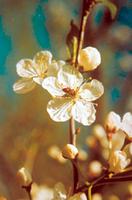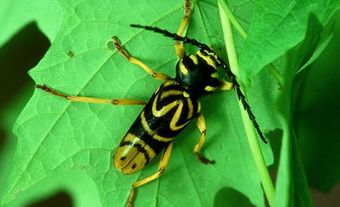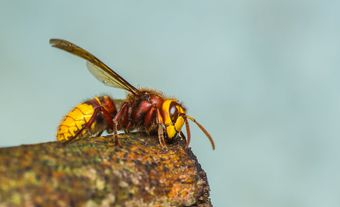
Most insects are beneficial, playing many ecological roles. Less than 1% are pests. They are the principal food of many birds and reptiles, and the survival of insect-pollinated plants depends on them. Bees are not the only important pollinators; in northern Canada pollination is largely done by flies and butterflies. Plant-feeding insects also help maintain plant diversity, and without them, the most competitive plant species tend to dominate. Insects play a major role in plant succession, with bark beetles being particularly noticeable in forest succession. Finally, insects are important for recycling the nutrients from detritus.
Insects as Food
In many parts of the world, insects are used as human food (eg, grasshoppers and palm weevils). They have a highly digestible protein and energy source. There is a Canadian account, in Samuel Hearne's diary for 1771, that a chief of the Copper Inuit ate warble-fly grubs as a delicacy - they were said to taste like gooseberries. However, people from Europe are not receptive to knowingly eating insects. Thus, attempts to promote honeybee brood (a byproduct of the honey industry in the fall) by Dr B. Hocking from the University of Alberta did not catch on. However, most people unwittingly consume several kilograms a year in bread and flour.
Insect Products
The most widely used insect product is honey (see beekeeping). Other products include silk from the cocoon of the silk-worm moth; shellac from the secretions of a scale insect on fig trees in Asia; and red dye from the cochineal insect on cactus. Cochineal is regaining its favour as a food colouring because the cheaper coal-tar dyes that replaced it earlier in the century have been implicated in causing cancer. Insects are important tools for research on genetics and population dynamics because of their relatively short generation time. Finally, butterflies, dragonflies, beetles and other insects have long provided an inspiration for art, literature and music.
Insects in Medicine and Environmental Health
For many years before the advent of antiseptics and antibiotics, flesh-eating fly larvae were used to clean wounds, since, in spite of their name, they ate the putrefaction and not the healthy tissue. Currently both the species and its developmental stage are used in forensic science to determine the date of death for cadavers found outdoors. Insect species and diversity, particularly in aquatic habitats, are sensitive indicators of environmental health. Thus, both small levels of pollution and recovery after pollution are reflected by changes in the composition of insect communities. Changes in the species composition of terrestrial insect communities are also being monitored as early indicators of global warming effects.
Insects as Pollinators
An estimated 80% of our food plants are dependent on animals, almost all being insects, for pollination. Honeybees alone have been estimated to be worth one billion dollars annually for their pollination services to Canadian agriculture. Tens of thousands of hives are moved around North America by beekeepers for crop pollination of apples, pears, cherries, field cucumbers and oil seed crops. Alfalfa is pollinated by leafcutting bees. Pumpkins and squash are pollinated in eastern Canada by the specialist hoary squash bee. Blueberries are pollinated by a diverse assemblage of wild bees and cranberries by bumblebees. The greenhouse industry uses bumblebees for pollination of tomatoes and peppers. In tropical regions, cacao is pollinated by midges (no-see-ums) and oil palm by weevils.
Biological Control
One of the largest group of insects, the parasitic wasps with about 200 000 species, attack other insects. Their use in controlling pests is called biological control. Most tomatoes and cucumbers grown in Canadian greenhouses depend on regular release of parasitic insects (inundative biological control) to control white fly and other pests without insecticides.
Parasitic insects from other parts of the world are established in Canada as a means of reducing, on a continuing basis, the abundance of introduced pests. This is called classical biological control. An example is the European spruce sawfly, which before 1930 was spreading rapidly and causing devastating losses in eastern Canadian spruce forests. The introduction of parasitic wasps, and a virus disease spread by the wasps, reduced the sawfly to a minor pest.
Plants introduced from other countries without their natural enemies often become weeds. The reuniting of specialized natural enemies with their host is used extensively in Canada against introduced weeds of range and uncultivated land. In the interior of BC in 1950, a European weed, Saint-John's-wort, was replacing the native flora and forage plants. The establishment of a European beetle that eats only Saint-John's-wort has, in most areas, reduced the weed to 1% of its former density, and has done this without damage to other plant species. This approach is often the cheapest solution for the control of introduced weeds and avoids the undesirable effects of herbicides, but it may take 20 years.
Canadian researchers pioneered the use of a beetle that feeds on seed heads in order to control another European weed, the nodding thistle. This insect has now been used successfully in so many countries that, on a geographical basis, it is one of the most successful biological control projects in the world.
Other Ecological Roles Played by Insects
Some plants use ants to plant their seeds. This is called myrmecochory and principally benefits the plant. In these plants, the seed has an elaiosome (ant-attractive appendage) containing oils and various chemicals that compels some ant species to take it to the nest. Here the elaiosome is eaten and the undamaged seed is discarded in an abandoned gallery, which is moist, fertile and safe from predation by birds and rodents. The survival and growth of violets and other spring woodland flowers is increased because of myrmecochory. In bull thistle, burial-induced dormancy enables the plant to survive many years under an unsuitable cover such as forest. More commonly, ant species collect seeds to eat them but lose some in the process. This is a mutualistic relationship in which the ants are fed and the seed dispersed. A few ants, known as harvester ants, go one step further and establish seed granaries, which principally benefits the ant.
Insects have a major recycling role. Dung beetles bury dung as food for their larvae. Burying beetles are striking insects that similarly dispose of carrion, while wood-boring beetles and termites do this for dead trees and plants. Termites, where they are common, also have a major soil-building role. Springtails are extremely common and often overlooked soil insects that largely feed on fungal hyphae. They are thought to regulate the soil microbial community and plant-microbe interactions, and hence plant production.

 Share on Facebook
Share on Facebook Share on X
Share on X Share by Email
Share by Email Share on Google Classroom
Share on Google Classroom



